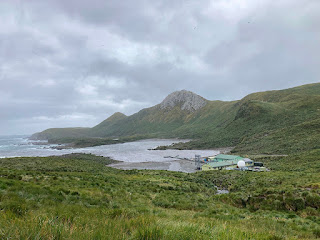As we reach late February, the summer here is already starting to draw to a close. The weather has become quite wild and windy, and today it was only just above freezing and the showers were falling as snow. The days are getting shorter, and it’s still fairly dark at 7am when I get up, and getting dark again by 9pm. The wildlife that has been breeding this summer is growing well, with our first chicks already ready to leave the island.
The gentoo chicks have grown quickly, and are now learning to swim and feed themselves. They are now fully feathered and look very much like the adults. The adults are now the ones that look scruffy- once they have finished breeding, they come ashore for a few weeks to moult all of their old feathers and replace them with new. For a while they look quite rough- this shows one that has finished moulting, and one that is partly moulted.
The macaroni penguin chicks have grown well. In this picture you can see how big they were a couple of weeks ago (there are adults and chicks in this colony- the adults have yellow crests).
The Macaroni chicks are now ready to leave the island and we have been watching them take their first dip in the sea. For them this is much more of a commitment- while the gentoos can just take an easy paddle and swim in the shallows of a sheltered beach, the first encounter of the sea for the macaroni chicks is a big leap off a ledge into the churning ocean below. The Macaroni’s breed in enormous colonies- this is Big Mac, our biggest colony, home to around 30,000 pairs of penguins. The colony appears pink due to the guano, because they eat krill (a pink shrimp-like creature). Each tiny dot is a macaroni penguin nest.
The giant petrel chicks take a little longer than the penguins to develop. Some are still quite small and fluffy…
While others have now lost their downy fluff and are showing their feathers. It will be another month before these fledge.
The Antarctic fur seals that live around us have changed from little black fuzzy creatures to very smart little soft grey seals that are also now happily playing in the water. They have enormous amounts of character and are very comical to watch.
We are now only a few weeks from the end of the season and are already starting to finish off projects and start packing cargo to send out on the ship- I’m not quite sure where the last couple of months have gone! We’ve also had some fun days out exploring the less visited areas of the island on nice days, and I’ll put some pictures of those on here soon.













